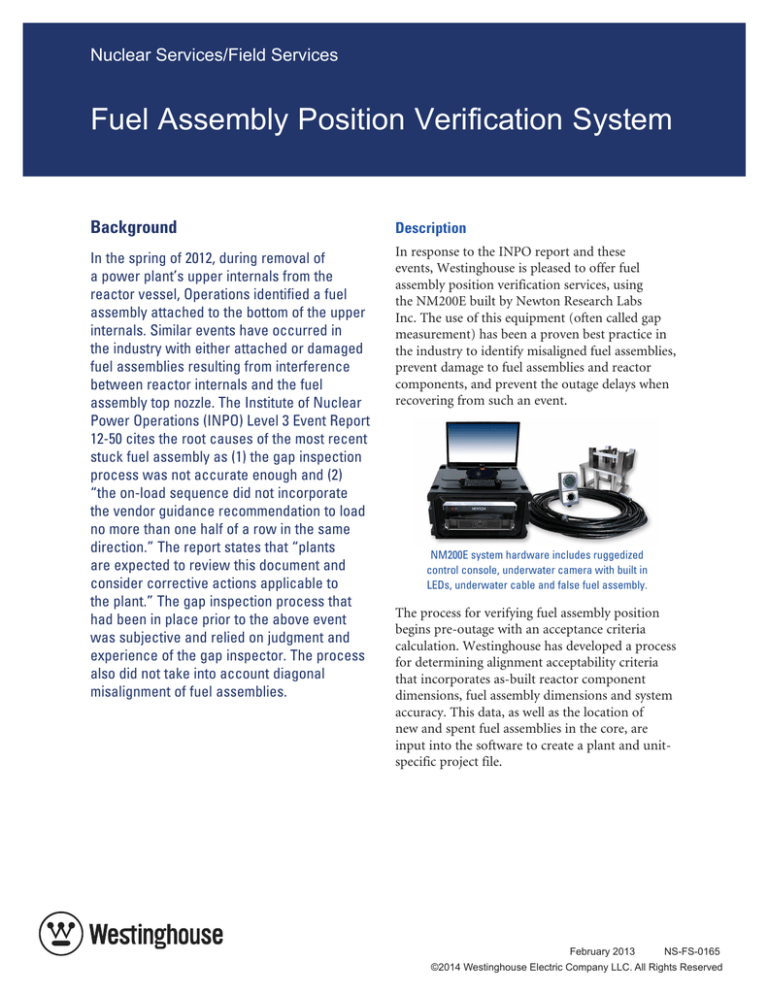
Nuclear Services/Field Services
Fuel Assembly Position Verification System
Background
Description
In the spring of 2012, during removal of
a power plant’s upper internals from the
reactor vessel, Operations identified a fuel
assembly attached to the bottom of the upper
internals. Similar events have occurred in
the industry with either attached or damaged
fuel assemblies resulting from interference
between reactor internals and the fuel
assembly top nozzle. The Institute of Nuclear
Power Operations (INPO) Level 3 Event Report
12-50 cites the root causes of the most recent
stuck fuel assembly as (1) the gap inspection
process was not accurate enough and (2)
“the on-load sequence did not incorporate
the vendor guidance recommendation to load
no more than one half of a row in the same
direction.” The report states that “plants
are expected to review this document and
consider corrective actions applicable to
the plant.” The gap inspection process that
had been in place prior to the above event
was subjective and relied on judgment and
experience of the gap inspector. The process
also did not take into account diagonal
misalignment of fuel assemblies.
In response to the INPO report and these
events, Westinghouse is pleased to offer fuel
assembly position verification services, using
the NM200E built by Newton Research Labs
Inc. The use of this equipment (often called gap
measurement) has been a proven best practice in
the industry to identify misaligned fuel assemblies,
prevent damage to fuel assemblies and reactor
components, and prevent the outage delays when
recovering from such an event.
NM200E system hardware includes ruggedized
control console, underwater camera with built in
LEDs, underwater cable and false fuel assembly.
The process for verifying fuel assembly position
begins pre-outage with an acceptance criteria
calculation. Westinghouse has developed a process
for determining alignment acceptability criteria
that incorporates as-built reactor component
dimensions, fuel assembly dimensions and system
accuracy. This data, as well as the location of
new and spent fuel assemblies in the core, are
input into the software to create a plant and unitspecific project file.
February 2013
NS-FS-0165
©2014 Westinghouse Electric Company LLC. All Rights Reserved
Following core reload
on-site, a “false fuel
assembly” that houses
a robust underwater
camera is lowered
into the reactor cavity.
The camera is then
gripped by the refueling
machine and moved to
several pre-determined
locations throughout
the core. At each stop
False fuel assembly on
the system collects data,
refueling machine gripper
and using proprietary
machine vision
software, computes the actual position of the
fuel assemblies within the core. Using the inputs
previously entered into the project file, the system
then analyzes the data and calculates where the
fuel assemblies are compared to where they should
nominally be located. This process is repeated
real-time at each stop, with results becoming more
accurate and complete as more data is collected.
The end result is an output file showing the ideal
and actual location of each fuel assembly, and
whether or not they are within the calculated
acceptable range.
Benefits
• Quantitative analysis removes the subjectivity
from previous “gap verification processes”
• Actual position of alignment features (e.g.,
S-holes) is determined. Other methods relying
only on gaps, a relative measurement, leave
room for error and do not incorporate any
twist or rotation in top nozzles
• System is quickly and easily deployed/retrieved
• Efficient process reduces outage critical path.
Real-time analysis means no more waiting for
digital caliper measurements or video recording
and review
• Robust hardware is designed and built to
prevent foreign material from entering the
reactor coolant system
Experience
Westinghouse has successfully performed a fuel
assembly position verification service at a U.S.
power plant in November, 2012. The full process
was completed in less than three hours, and the
system concluded that all 157 fuel assemblies were
safely positioned within the core. Several other
power plants have also successfully deployed the
NM200E system.
Screenshot of live video overlay
Westinghouse Electric Company
1000 Westinghouse Drive
Cranberry Township, PA 16066
www.westinghousenuclear.com

